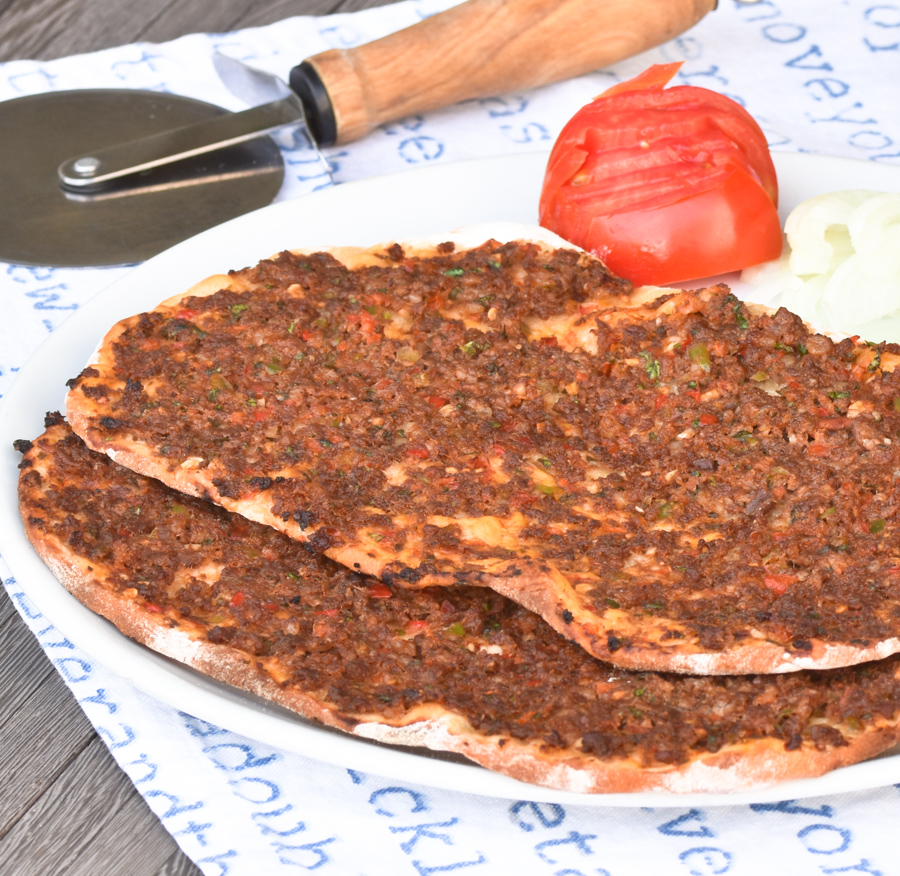
Gaziantep Lahmacun
Gaziantep Lahmacun (Video)
Turkish lahmacun takes its name from the Arabic word lahm bajeen which literally translates to meat and dough. A popular street food also throughout Lebanon, Syria, Iraq and Armenia, with countless incarnations. They all fall in the same category: an elongated flat dough smeared with fatty minced lamb or beef, diced veggies and spices where both bread and topping are baked at the same time; but have you ever tried the Gaziantep version of Lahmacun? If not, you are seriously missing a lot! Located in the southeast Anatolia Region in Turkey, Gaziantep is well-known for its long gastronomic history. It is fabled for its cuisine and has the reputation for being home to the best lahmacun, baklava and kebabs. One of the things I like about Turkish cuisine is that it is so regional, you will notice when traveling from one region to the next across the country, that the cuisine changes depending on the region. Here is a detailed post to teach you how to make the legendary Gaziantep lahmacun.
Here is a step-by-step video to make the process more comprehensive and to show you exactly how to get the perfect Gaziantep Lamhacun.
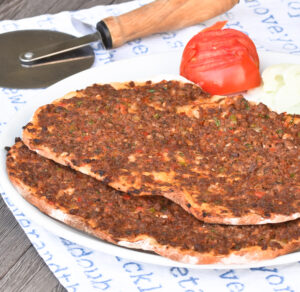
Gaziantep Lahmacun
My first experience with Gaziantep lahmacun was a few years ago at a small restaurant in Istanbul. There were two choices of lahmacun on the menu: The Sanliurfa and Gaziantep version. The waiter explained that Turkey is jammed with incredible restaurants and bakeries that have numerous versions of lahmacun, but the most two common are the Urfa and Antep version—that’s how frequently locals shorten the name of both cities—and the main difference between both is that the first is made with onions while the latter uses a copious amount of garlic. He elaborated further by stating that locals in Gaziantep will argue stringently that their lahmacun is the only one that counts, on the other hand, many will argue that the title belongs to Urfa instead, so expect a heated argument as the debate rages on: who has the best lahmacun, Gaziantep or Sanliurfa?
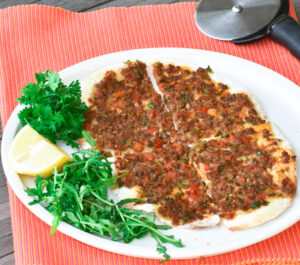
Since garlic-based dishes always earn my attention, I had to order the Gaziantep lahmacun. I was served a super thin, crispy and crackled baked oval dough heaped with the most flavorful packed mixture of minced meat and veggies—similar to the Lebanese Lahm b3ajeen but with deeper flavor notes. I spent each following bite trying to analyze precisely what it was I was eating and why was it so good? A pleasant savory sensation I had never experienced, that made the wrap fall directly into that category of comfort food. A thin dough packed with a special mix of minced meat, red bell pepper, green bell pepper, tomatoes and garlic; it nails the perfect balance of crispy dough and meat topping that could stand up to the best pizzerias of the world, or maybe the uncontrolled inner voice meat-lover in me speaking now, so please don’t judge me.
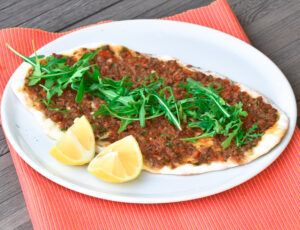
I had to learn it by all means! Earlier this year my Turkish friend “Emir” showed up in my kitchen to teach me from start to finish how to make the Gaziantep lahmacun. We spent a few hours working on the recipe, I was ready to absorb everything I saw, and I am here to pass the recipe along to you, with hope that it will inspire you to try it one day in your kitchen.
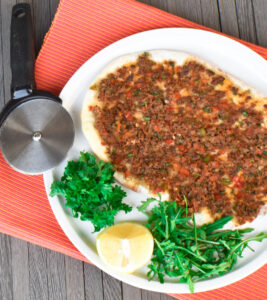
And now let’s get started!

Making the dough:
- To make the dough, use instant yeast, so you can integrate it right in the dough without proofing it with water first.
- Usually, lahmajun is cooked in a stone oven, you can have much of the same effect by preheating an oven sheet for about half an hour before baking, so it’s screaming hot by the time you gently transfer the dough in. That ultra-hot environment is what gets you the kind of crust you would expect from a bakery.
To make the dough: In a large bowl, combine the flour, instant dry yeast, sugar, salt and oil. Add the lukewarm water and mix well. Knead until you get a malleable dough of one texture. Slam it a couple of times on a countertop, this will strengthen the gluten in the flour, resulting in a very light and fluffy dough. Transfer to a lightly greased bowl, cover with cling film and set aside for 1 1/2 hours. Giving the dough some time to rest ensures it’s easy to work with.
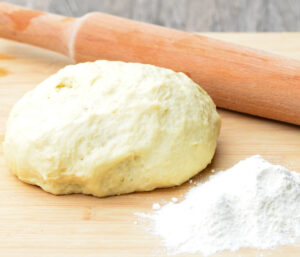
Once the dough has been rested, dust your work surface lightly with the flour; divide it to 8 even-sized portions and gather each into a ball. Cover with a kitchen towel, and set aside to rest for 15 minutes.
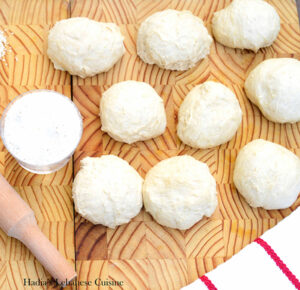
Making the topping:
- Traditionally lahmacun pies are made with lamb meat, but if lamb is too strong for you, beef can be used instead; fatty meat is advisable and not the lean stuff.
- Cut the veggies, for the topping, using a serrated knife; purist believe that chopping has to be done by hand to get the right texture. In Turkey they use a special knife called “Zırh” which looks like a sword with a curved blade rather than a knife. It is used for making proper kebab and lahmacun, but a serrated knife would do the job just fine.
Finely dice the red bell pepper, green pepper, tomato, garlic cloves, red hot pepper (if used) and parsley, then mix everything together and dice thoroughly one more time with a serrated knife, until you reach a chunky purée.

Incorporate the meat, tomato paste, sumac, salt, cumin powder, paprika and hot red pepper (if used). Mix well to homogenize everything together. The mix should be that of a paste consistency.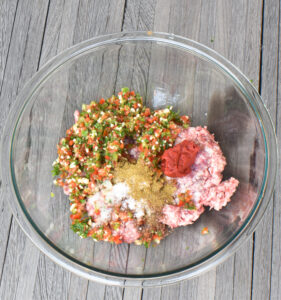
Dust your rolling pin, roll out one dough on a floured countertop to a thin oval (6×9) inches/ (15×22) cm, and about 1 1/2 mm thin. Transfer it to a parchment paper or silicone baking mat and spread 1/8th of the topping mixture onto the dough. Make sure all parts including the edges are well coated. Carry it to the heated sheet in the oven, beware not to burn your hands.
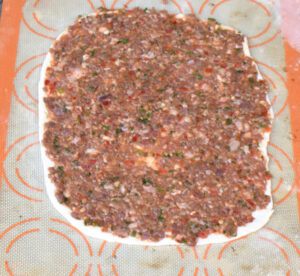
Bake about 8-9 minutes until lightly browned and crispy on the edges. Repeat with the remaining dough.
Serving Lahmacun
To serve, pile some arugula, or parsley on top of your lahmacun, dress with freshly squeezed lemon juice that will add a serious punch of flavor, add some onion wedges, wrap and enjoy.
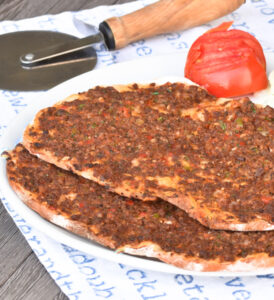
It was such a hit that my family begged me to make it again later this week, a great benefit of lahmacun is that the dough and filling can be prepared and refrigerated ahead of time and then rolled and baked just before you plan to serve them, but beware, the trick to rolling out this dough very thinly is to ensure it is at room temperature before you start. If your dough is too cold, it will be too elastic and difficult to work with!
- Author:Hadia Zebib Khanafer,
- Prep Time: 2 hours
- Baking time: 8 minutes
- Serving : 8 lahmacun
Watch the video tutorial above to make the process more comprehensive and to show you exactly how to get the perfect Gaziantep Lamhacun.
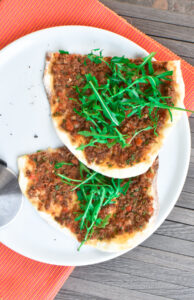
Ingredients:
The Dough:
- 500 grams / 1 lb. 2 oz. all- purpose flour
- 300 ml / 1 1/4 cups lukewarm water (you may need a bit more than the mentioned amount, simply because different flour brands have different water absorption)
- 1 teaspoon granulated sugar
- 1 teaspoon instant dry yeast
- 1 teaspoon salt
- 1 tablespoon olive oil
The Topping:
- 750 grams/ 1 lb. 10.5 oz minced lamb meat, 30 percent fat
- 1 1/2 heaped tablespoons tomato paste
- 1 large red bell pepper, diced
- 1 large green bell pepper, diced
- 1 cup parsley, finely chopped, stems removed
- 7 large garlic cloves,
- 1 large tomato
- 1 1/2 teaspoons sumac
- 1 1/2 teaspoons cumin powder
- 1 1/2 teaspoons Turkish pepper paste (biber salcasi) / or paprika
- 2 teaspoons salt, or to taste
- hot red pepper, to taste, optional but recommended
- A dash of freshly grated black peper
Directions:
- To make the dough: In a large bowl, combine the flour, instant dry yeast, sugar, salt and oil. Add the lukewarm water and mix well. Knead until you get a malleable dough of one texture. Slam it a couple of times on a countertop, this will strengthen the gluten in the flour, resulting in a very light and fluffy dough. Transfer to a lightly greased bowl, cover with cling film and set aside for 1 1/2 hours. Giving the dough some time to rest ensures it’s easy to work with.
- Half an hour prior to baking, place the oven sheet you are going to be using, and preheat to the highest heat setting available in your oven, so it’s screaming hot, the ultra-hot environment is what gets you the kind of crust you would only expect from a bakery.
- Meanwhile, prepare the topping: finely dice the red bell pepper, green pepper, tomato, garlic cloves, red hot pepper (if used) and parsley, then mix everything together and dice thoroughly one more time with a serrated knife, until you reach a chunky purée. Now incorporate the meat, tomato paste, sumac, salt, cumin powder, paprika, black pepper and hot red pepper (if used). Mix well to homogenize everything together. The mix should be that of a paste consistency.
- Once the dough has been rested, dust your work surface lightly with the flour; divide it to 8 even-sized portions and gather each into a ball. Cover with a kitchen towel, and set aside to rest for 15 minutes.
- Dust your rolling pin, roll out one dough on a floured countertop to a thin oval (6×9) inches/ (15×22) cm, and about 1 1/2 mm thin. Transfer it to a parchment paper or silicone baking mat and spread 1/8th of the topping mixture onto the dough. Make sure all parts including the edges are well coated. Carry it to the heated sheet in the oven, beware not to burn your hands.
- Bake about 8-9 minutes until lightly browned and crispy on the edges. Repeat with the remaining dough.
- To serve: pile some arugula, or parsley on top of your lahmacun, dress with freshly squeezed lemon juice that will add a serious punch of flavor, add some onion wedges, wrap and serve piping hot from the oven.
- Thank you to all the readers who purchased “Hadia, Lebanese Style Recipes”. If you have a minute to spare, please rate and review the book on Amazon. We would like to know what you think! Here is the link to AMAZON

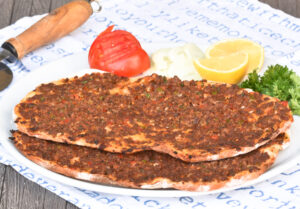
Looking for more meat pie recipes, check the recipes below!

Lebanese Meat Fatayer/ Lebanese Meat Turnovers

If you make "Gaziantep Lahmacun", leave a comment below, or share your pictures on Facebook! I would love to see your creations!! Hashtag, #Hadia’s lebanese Cuisine
Subscribe to Our Newsletter
Instructions
No Steps Found !
- Course : APPETIZERS, BREAKFAST, MAIN DISHES
- Recipe Type : APPETIZERS, BREAKFAST, MAIN DISHES, RECIPES FROM AROUND THE WORD
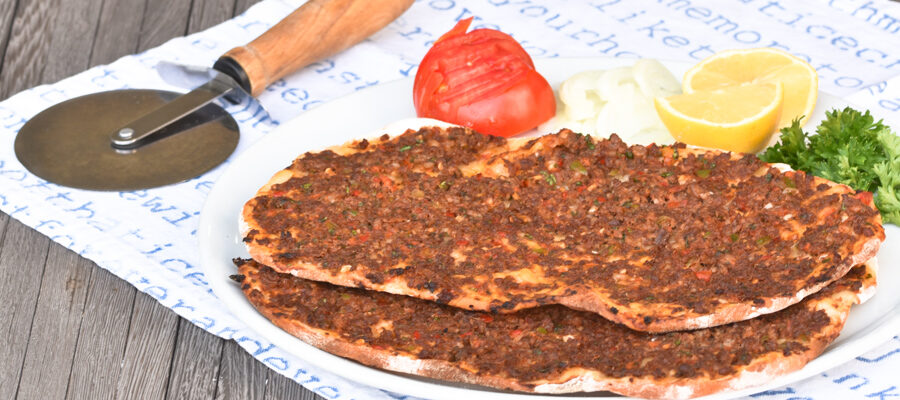
2 Responses to Gaziantep Lahmacun
Leave a Reply Click here to cancel reply.
About Chef
Hadia Zebib
I am Hadia, the face behind Hadia’s Lebanese Cuisine. I grew up in Beirut Lebanon and I currently reside in Kinshasa, Congo with my husband and my three adorable sons, ...
Read more about this chef..

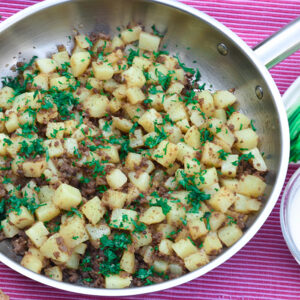
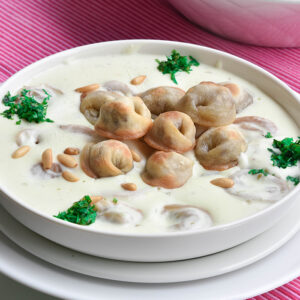
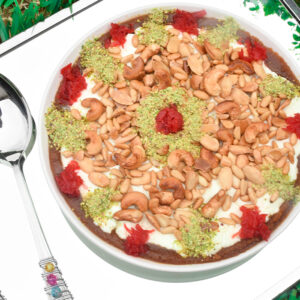


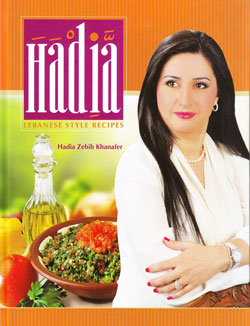
This looks absolutely amazing! My youngest the carnivore in our house would devour these in no time. Definite must make. Pinning for later.
Thank you Ann, I hope your son would enjoy it as much as we do, it is an amazing recipe. Thank you too for pinning!